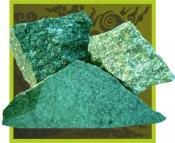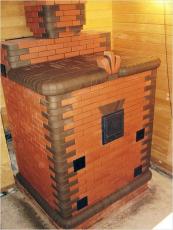Search
Login
Kamenka stoves for a Russian bath, a stove with a closed stove, a stove with a tank
Since the furnace is an integral and significant part of the bath, you will need to think carefully about which device: electric, metal or brick, will provide the optimum temperature in the steam room. Experienced steam workers claim that wood-burning stoves are the most preferred option. A brick-fired wood-burning stove Kamenka is traditionally constructed in a Russian bathhouse, provides it with heat and steam, inimitable comfort and coziness.
Content:
- Types of stoves stove for a Russian bath video
- Closed heater, design and operation features
- Closed heaters of periodic action
- Features of a continuous operating principle heater
- Advantages of a closed heater
- Kamenka stove with tank, its features video
- Do-it-yourself stove stove - some tips from the masters video
- How to care for a stove heater
Types of stoves stove for a Russian bath
Since very responsible functions are assigned to the bath stove, the requirements for it are also put forward quite serious:
- ensuring the optimum temperature in the steam room - about +80 C under the ceiling, +45 C - above the floor surface,
- humidification produced by pouring water on hot stones,
- do not emit carbon monoxide and smoke into the steam room,
- safe operation
- economical fuel consumption.

Stones in the furnace can be arranged in different ways, depending on this furnace there are:
- with an open heater,
- with a closed heater.
It is stoves with a closed heater that are more consistent with the idea of \u200b\u200bwhat a Russian bath should be, and they can create the most favorable atmosphere for soaring and relaxation.
Features of the design and operation of a closed heater
Consider what the main differences of this option are. To prevent smoke from entering the room, the steam doors of the oven should not open, this will prevent smoke from entering the steam room.
In closed-type heaters, it is customary to install a steam door slightly higher than the level of the upper row of stone backfill. The door is opened before entering the steam room and wait until the temperature in it rises to + 50 +60 C.
It will take a lot of time to warm up a bath with such a heater - the stove starts to be heated a couple of hours before the planned entry to the steam room, and the fuel consumption will naturally be increased. To achieve the optimum temperature in the steam room, you need to thoroughly warm the stones.
Closed heaters of periodic action
The operation mode of the stoves can be periodic or constant, i.e. long lasting. Batch furnaces have a significant advantage - they are able to retain heat for a day or two. The furnace is equipped in such a way that the stones on the brazier are heated by heat from the furnace or from the smoke passing through them. This design allows the stones of the upper layer to warm up to a temperature of +1000 C, the lower - up to +650 C.

Since the stones in the firebox are in the area of \u200b\u200bsmoke passage, a deposit of soot appears, which burns out at a high temperature of the stones.
Therefore, it is better to use such a bath immediately upon completion of the combustion process, immediately after all the firewood is completely burned.
If these recommendations are not followed, then carbon monoxide can enter the room - a compound toxic to humans. From the time the stove is fired up and before entering the steam room, it usually takes from three to five hours.
Features of a continuous operating principle heater
The permanent stove heater, the drawings of which provide for a firebox, blower, chimney, stone filling, acts in a slightly different way: the stones are heated from the red-hot walls that separate the heater from the furnace.
The maximum temperature for heating stones in this case is from +400 С to +500 С, the heating of a steam room starts with the heating of stones. For the manufacture of a housing of a permanent heater, refractory thick sheet steel (from 4 mm) is used.
The design of the furnace with a closed heater has some features.
Since the thickness of the firebox masonry is small, the furnace casing is usually placed in a metal casing, so hot air can circulate between the screen and the casing.
In order to prevent the contact of smoke and soot with stones, and therefore to prevent the possibility of contamination of the steam room, continuous furnaces provide for the stove to be protected from smoke by a cast-iron or steel plate.
Advantages of a closed heater
The steam room in the bathhouse with a closed-type heater is always clean, the air in it is filled with the aromas of a broom or specially brewed herbs - after all, such a stove is heated from the room next to the steam room.
The stones warm up evenly, the steam formed from them is very light, saturated with tiny drops of water.
High temperature with steam of this quality is quite easily tolerated.
Closed-type structures are simpler and safer to operate - they virtually eliminate the possibility of burns during steam formation.
The stones inside the furnace retain their acquired temperature for a long time, so the furnace does not need to be heated during the entire period of soaring.

Of the disadvantages of furnaces of this type should be noted:
- a long period of heating the steam room and, accordingly, increased fuel consumption,
- Given the shortcomings of a brick-built heater, fans of the steam bath in their own sauna increasingly resort to installing metal furnaces - they heat up much faster, water procedures can be started half an hour after the furnace starts. But these furnaces cool too quickly. By design, metal furnaces can also be different, have an open or closed heater. It will be required to heat such a furnace throughout the entire process of soaring.
Kamenka stove with tank and its features
It should be remembered yet another structural element of the bathhouse furnace - a tank or boiler. The design of most furnaces involves placing it on top.
There is also an option when the tank is pushed one side into the firebox.
Do-it-yourself stove stove built on this principle, nevertheless, has some advantages. if we consider the option with the top location of the boiler, then the water in it comes from two sources - from hot stones below and from the chimney going through the boiler.

The conditions of high-quality evaporation suggest that the boiling of water should not occur quickly, then the option seems quite thought out.
But on the other hand, insufficiently purified water eventually forms scale on the walls of the boiler, which, of course, will need to be removed.
For the winter period, the water from the tank will have to be drained, since all the water cannot be completely removed through the tap, you will have to scoop it out with a bucket.

It turns out to be more attractive to use the option of placing the heater on the side of the furnace, and the boiler above it. In this case, the boiler is attached to the beam using ropes or chains, in this case, less time will be required to heat the water.
If the water begins to boil before the stones warm up - the tank can be added with cold water.
In this case, the tank is used in a rounded shape with a semicircular bottom, it will be much easier to clean it and pour out the remaining water from it than in the case considered above.
They don’t equip such a tank with a faucet, to use hot water they use a bucket.
In this case, heat preservation in the bath will be provided not at the expense of the boiler, but at the expense of stones filling the heater. They will warm the air in the steam room.
In order to bathe in several runs, such a bath will have to be flooded all the time, especially in the winter.

A built-in stove with a do-it-yourself heater, with a tank installed at the furnace level, will allow you to get rid of all the above disadvantages.
Since the tank will be quite low - the process of cleaning and filling it will be greatly simplified. The order of the stove heater in this case is selected with a long firebox, which will be conveniently heated with logs of a standard size.
By one third of its width, the tank can protrude into the washing room, the rest of it should be covered with brickwork.
It is not difficult to determine the size of the tank, it is considered that with a normal flow rate, one person will need up to 10 liters of water.
As a rule, a steam room is designed for 5-7 people, therefore, about 70-80 liters will be required for hot water. For the manufacture of the tank using stainless steel with a thickness of 1 mm.
If we talk about the sauna, then the boiler with water in it is always placed outside the steam room - the humidity level in the room should not exceed 25%.
Do-it-yourself stove stove - some tips from the masters

- During the construction of the sauna furnace, red burnt brick should be used; for the construction of the furnace, refractory brick is required. In the order of the stove, the heater indicates that 230 pieces are needed for the stove. ordinary red brick and 12 - refractory.
- Masonry is performed on a solution made of coarse sand and clay. The sand is used dry, pre-sieved. Clay before masonry is soaked for a couple of days. The solution is kneaded immediately before masonry.
- It is recommended to mix sand and clay in a ratio of 1/2 or 1/3, if the clay is oily - 1/5.
- To check the density of the mortar, the following experiment is done: the mortar collected on the trowel must slide off (if it does not slip, add water and sand), it should not spread on the surface of the brick (if it spreads, add clay).
- You can improve the quality of the solution by adding salt to it - about 1 kg per bucket, or cement - about 1/8 of the volume of sand. Salt and cement cannot be added together! A furnace folded into such a solution will not crack due to frequent changes in temperature.
- Sometimes asbestos chips are added to the solution, in a proportion of 1/1 to the sand.
- The laying of the furnace requires certain knowledge, skills to do the work, if you plan to do the laying yourself, then you must definitely find an experienced consultant. His hints and recommendations will help to do the job efficiently.
How to care for a stove heater

Any of the selected types of heaters during operation will require regular inspections. It is also advisable to look at the stones and replace those cracked by heat.
Since when the furnace is heated and cooled, the masonry undergoes mechanical loads caused by the expansion and contraction of materials, then it will begin to collapse over time.
If cracks or cracks are found, they will need to be covered with clay solution. Otherwise, smoke will actively penetrate the steam room.
Constant monitoring of the state of the stove will allow it to operate for a long period without major repairs.





